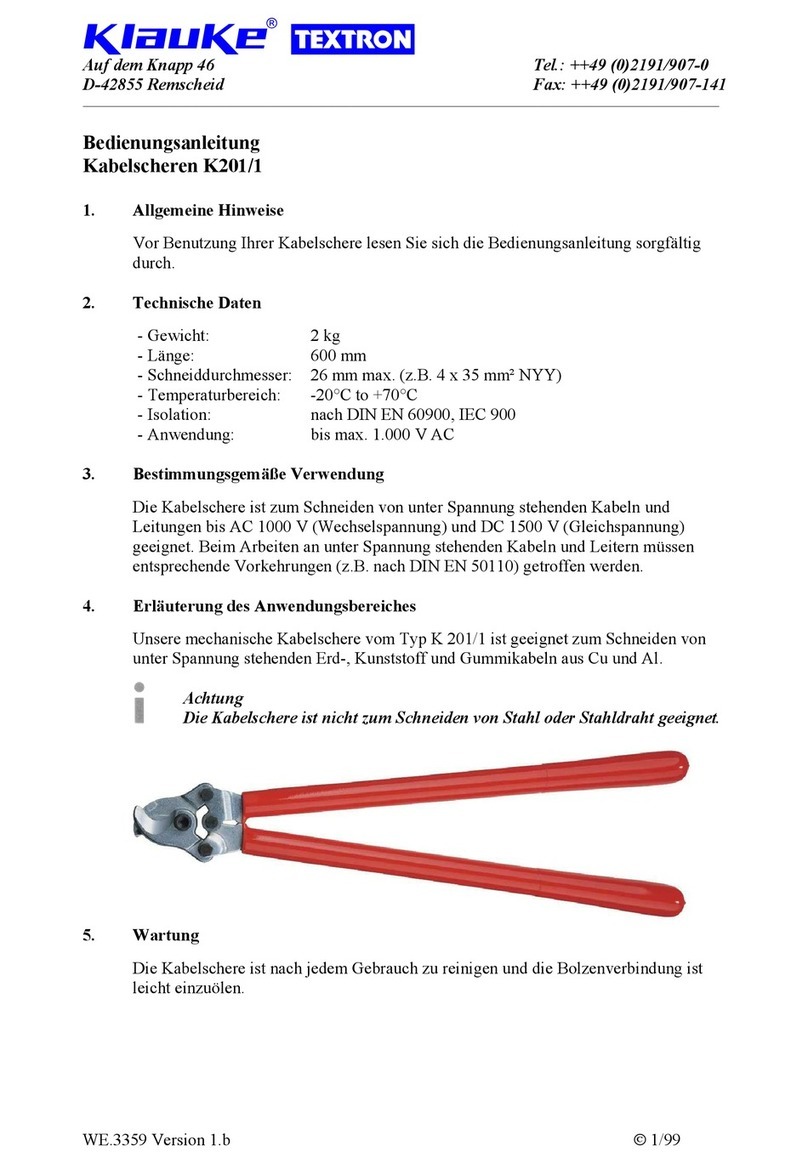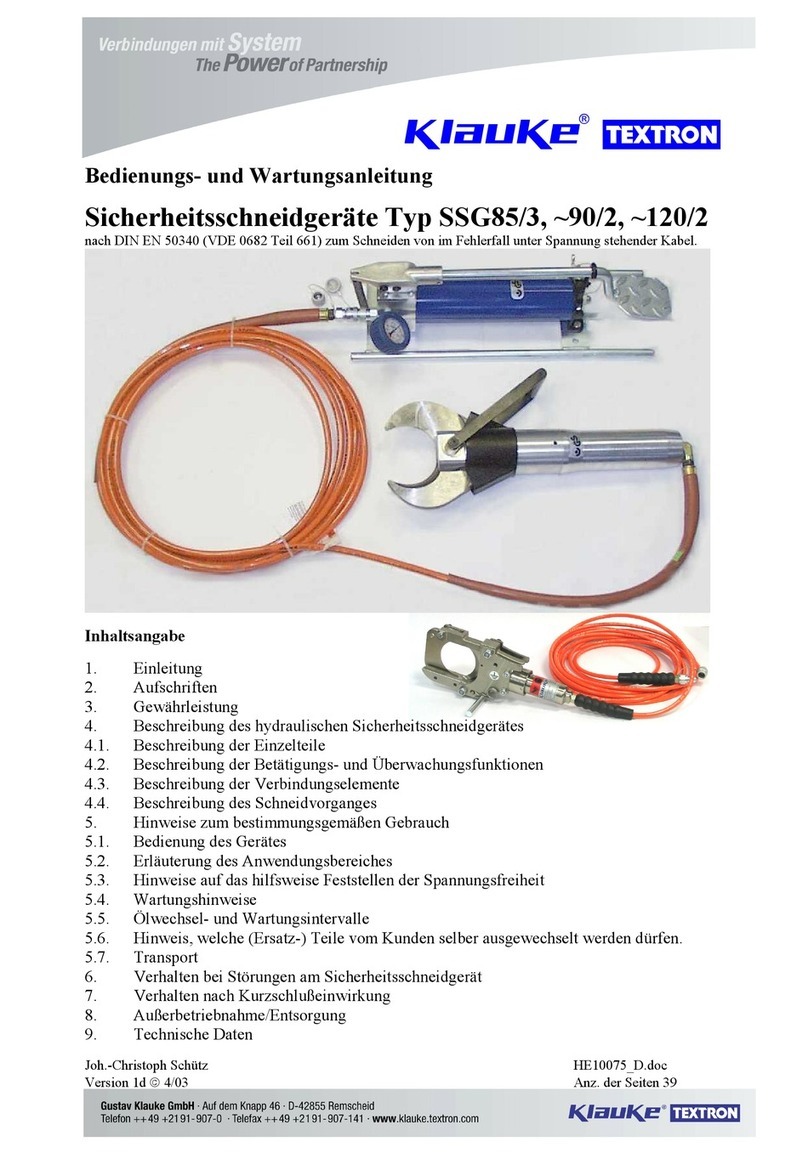
Mode d’Emploi ESG 50 plus page 10
_______________________________________________________________________________________________________________________
5. Indications relatives à l’utilisation conforme
Avant le début du travail, toutes les pièces actives, c’est-à-dire
conductrices sont à déconnecter dans l'environnement de travail du
monteur. Si ceci n’est pas possible il faut prendre les mesures de
protection correspondantes2pour le travail à proximité de pièces sous
tension.
L’état de charge de l’accu (pos n° 7) doit avoir été vérifié avant le
début du travail. Un niveau de charge trop faible peut par exemple
être reconnu à la diode électroluminescente (pos. n° 6) qui est
allumée en continu pendant 20 s à la fin d’un processus de coupe.
Maintenez votre environnement de travail propre et rangé. N’utilisez
pas cet outil si vous êtes fatigué ou sous l’influence de drogues,
d’alcool ou de médicaments.
5.1. Commande de l’appareil
Décliqueter tout d’abord le verrou à crans rabattable (pos. n° 3)
(fig. 2, position A), puis ouvrez la tête de coupe (pos. n° 4). Le
câble/conducteur est ensuite inséré dans la tête de coupe et celle-ci
entièrement fermée.
Attention
Avant déclenchement de l’opération de coupe, la tête
de coupe doit être bien fermée.
La manipulation du commutateur de commande (pos. n° 1) déclenche
l’opération de coupe qui est marqué par la rencontre
des ciseaux (pos. n°10) (fig. 2, position C).
Le ciseau mobile installé sur la tige de piston avance en poussée
rapide sur le câble. Après passage de l’appareil dans la course de
travail plus lente, le câble est cisaillé. Une opération de coupe est
terminée lorsque les garnitures des ciseaux (pos. n° 10) se recouvrent.
Attention
Avant remplacement des ciseaux veuillez
absolument retirer l’accu pour éviter toute
manipulation involontaire.
En appuyant sur le bouton de remise à l’état initial (pos. n° 2), les
ciseaux peuvent être remis dans la position initiale (fig. 2, position B)
en cas de panne ou d’urgence.
Attention
L’opération de coupe peut être interrompue à tout
instant en relâchant le commutateur de commande.
5.2. Explication du domaine d’application
La cisaille peut couper des câbles de cuivre et d’aluminium jusqu’à
un diamètre extérieur de 50 mm.
Attention
L’appareil est strictement réservé à la coupe de câbles
de cuivre et d’aluminium.
Attention
Il est interdit de couper des câbles et conduites
d’alimentation armés en acier ou avec une âme en
acier.
Si d’autres matériaux doivent être coupés, une consultation avec
l’usine est impérativement requise.
Attention
La coupe de pièces sous tension est
strictement interdite.
En ce qui concerne le ESG 50 plus, il s’agit d’un appareil manié à la
main qui ne doit pas être placé dans un étau. Il ne doit pas être utilisé
pour une application stationnaire.
L’appareil n’est pas apte pour un service continu. Une pause
d’environ 15 min doit être respectée après environ 30-40 opérations
de coupe consécutives afin de laisser refroidir l’appareil.
2Voir DIN EN 50110-1
Attention
En cas d’utilisation trop intensive, des dommages
peuvent survenir à l’appareil par suite d’échauffe-
ment.
Attention
Le fonctionnement de moteurs électriques peut
conduire à la formation d'étincelles qui peuvent mettre
le feu à des matières inflammables ou explosives.
Attention
L'utilisation de la cisaille électro-hydraulique est
interdite lors de fortes pluies ou sous de l’eau.
5.3. Indications de maintenance
La cisaille doit être nettoyée après chaque utilisation et stockée
au sec. Non seulement l’accu mais aussi le chargeur doivent être
protégés de l’humidité et de corps étrangers.
L’appareil est sans entretien, uniquement les articulations d’axes sont
à huiler légèrement.
Attention
Maintenez les ciseaux aiguisés et propres et graissez
régulièrement les guidages.
Dans le cadre de l’utilisation conforme, le client est en droit de
remplacer uniquement les garnitures de coupe (pos. n° 10).
Attention
Ne pas endommager le scellé de l’appareil !
Le droit à la garantie expire si le scellé de l’appareil est détérioré.
Faites seulement réparer votre appareil par du personnel qualifié et
uniquement avec des pièces de rechange d’origine. Ainsi est assuré
que la sécurité de l’appareil reste intacte.
5.4. Indications sur l’utilisation de l'accu et du chargeur
Le chargeur est conçu pour 230 V/50-60 Hz. De nouveaux accus
doivent être chargés avant la première utilisation. Pour le chargement
de l’accu, la prise du chargeur est insérée dans la prise de courant et
l’accu est placé dans le chargeur. Le temps de charge est d’environ
une heure. L’état de charge de l’accu3est visible au niveau de la
diode électroluminescente sur le chargeur.
Verte : l’accu est chargé
Rouge : l’accu est en cours de charge
Clignotement : l’accu n’est pas entièrement inséré ou
trop chaud, un signal acoustique retentit
Une fois l’opération de charge terminée, le voyant de charge passe à
nouveau au vert, et un signal sonore retentit simultanément pendant
5 secondes.
Il est strictement interdit d’utiliser un accu d’une autre marque, aussi
bien dans la presse que dans le chargeur.
Chargez votre accu dès que la vitesse de votre machine diminue
sensiblement, ou que l'affichage à l'appareil (voir chap. 4.3) indique
que l’accu est vide. Ne rechargez pas par précaution un accu
partiellement déchargé.
Si vous chargez un accu d’un appareil utilisé récemment ou qui a
été longuement exposé au soleil, le voyant de charge rouge peut
clignoter. Attendez dans ce cas un moment. La charge commence
après refroidissement de l’accu.
Si le voyant de charge clignote alternativement sur rouge et vert et si
un signal d’avertissement retentit pendant 20 s, cela signifie qu’un
chargement est impossible. Les pôles du chargeur ou de l’accu sont
salis par de la poussière ou l’accu est usé ou endommagé.
Si vous voulez charger deux accus l’un après l’autre, attendez 15 min
avant de charger le deuxième accu.
3L’état de charge de l’accu peut aussi être reconnu à la DEL de l’appareil
qui s’allume à la fin d’une opération de compression. Voir chap. 4.3.































